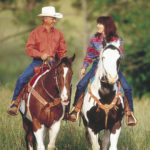Lisa Cunningham didn’t know what to do. Like many parents with autistic children, she was overwhelmed with the difficult behavior of her son Michael, and didn’t know what advice to take. Flipping the lights on and off, playing with his food, pacing the house at night when he couldn?t sleep. He wouldn?t make eye contact, listen to Cunningham or his teachers. Not a well-understood disease, it seemed everyone had a different opinion on the best ways to help Michael.

Cunningham would pass a sign for Back in the Saddle Equine Therapy Center every day on the way to work, but she was never convinced that riding a horse could really offer Michael the therapy he needed. One day, her car stalled just by the sign, and as she waited for assistance, she decided that maybe it was a sign her son needed to be enrolled in equine therapy. As soon as he climbed up on a horse, everything began to change.
?Connecting with horses like Micka and Hurango took away flickering the lights,? Cunningham said. ?Long rides on his horse helped Michael sleep through the night. The pacing in the house left after he would trot on the horse. Having to give the horse commands gave Michael a voice at home against his little sisters ? with eye contact! No more could they use him for dress up. Even brushing the horse, Michael started to want to do his own care, brushing his hair and teeth without me. Climbing up to the horse, our then five-year-old son learned to go up and down stairs foot over foot without fear.?
Cunningham is only one of the many parents that have discovered the immense therapeutic power of horseback riding for people of all ages with mental, emotional or physical disabilities. Back in the Saddle Equine Therapy Center (BITS), in Hopkinton, NH, was started by Pauline Meridian about eight years ago, when her daughter suggested that a couple of the horses she had grown up riding would be good horses for a therapeutic program. From there, they found a local therapeutic riding instructor and started offering classes at their farm. Now, BITS is a registered non-profit organization and offers many kinds of therapy, from hippotherapy for those with physical disabilities to the Spirit Horse autism therapy program that Michael is going through.
?In the physical arena, horse therapy is useful for children with both too tight and too loose limbs, cerebral palsy, down syndrome, muscular dystrophy, those kinds of things that affect joints and muscles and tendons and can be affected by a rhythmic walk on a warm horse,? Meridian said in an interview with Global Shift. ?It also helps with arthritis. For intellectual and emotional, we allow people to get more connected to people around them through a bond with a horse. The horses can model, you get direct feedback from that horse in their body language. If you’re scaring a horse, maybe you’re scaring other people.?
The program started with two horses, now they have seven. Meridian jokes that it’s really six and a half, because one of them is a miniature horse. Finding the right horses is essential to running an effective therapy program, because it’s the horses that are doing the work. The first thing Meridian looks for is that the horse has a calm temperament and is willing to work. These thousand pound animals can’t be nervous or flighty, they have to be gentle and be able to take care of the rider on their back. ?The horses aren?t just a tool, they?re almost a full partner in the equation,? she said. ?In the end it’s the horses doing the therapy, not us, so the horses have to want to engage with kids and adults and not be put off by loud behavior or strange movements.?
There’s no scientific formula for why equine therapy is so effective, but Meridian sums it up with, ?The horse doesn’t judge you.? It’s a clean slate with a horse, while these riders may have been to therapist after therapist, they can come to a horseback riding lesson, and the horse takes them for what they are. If you treat a horse well, it will treat you well. You can tell a horse all your troubles, and it won?t share your secrets. ?For thousands of years people used horses because they needed each other,? Meridian said. ?We still need each other. It’s not just to plow the field or go to war, but when we lost those connections we lost a lot. Bringing the horse back in a therapeutic way can help heal some of the things that people have always had to deal with.?
Michael is about halfway through the 98 steps of the Spirit Horse autism therapy program after six months of riding. Meridian said she has seen an amazing improvement in his balance and his ability to be comfortable with his horse and follow directions from an instructor. The benefits from the Spirit Horse autism therapy have been proven statistically significant, in both physical and emotional ways. A sample of riders was tested for strength and balance and physical fitness before and after 12 weeks of the program, and teachers and parents of the students were interviewed about the progress they had made. It all showed what a difference the program had made.
?On the surface it’s a pony ride but an awful lot more than that happens,? Meridian said. ?I think we have a unique paradigm of mutual dependence, much as humans have had for centuries, as our horses bring children with autism back from the edge of their worlds back to their families, and our own.?
You can learn more about Back in the Saddle Equine Therapy Center at their website.






